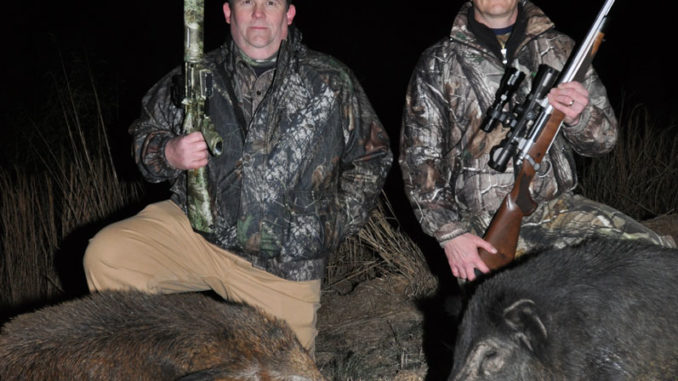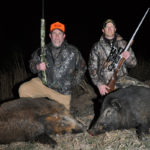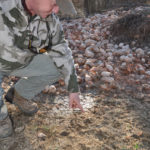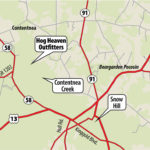
Targeting wild hogs after dark gives North Carolina hunters some extra adventure.
When North Carolina started allowing hunters to target wild hogs after dark, Milton Turnage was one of the first hunters to do so effectively. He began offering guided night hunts as soon as he was set up, in January 2012, after honing his techniques by hunting them during daylight hours for years.
“During deer season, a deer-hunting club and some family members use the farm where I hunt hogs primarily for hunting deer,” Turnage said. “But since it is a farming operation, they have always attempted to control the feral hogs on the property. They shoot them when they can while they are hunting deer, but that was not proving to be very effective.
“The hogs are detrimental to the farming operation because they eat crops at all stages, from when they are planted until they are mature and ready for harvest. They also consume tons of bait like corn and sweet potatoes that the hunters would rather were only feeding and attracting deer. A herd of hogs can eat a truckload of sweet potatoes almost as soon as they can find it.”
Turnage, who runs Hog Heaven Outfitters, leases the property, which is along Contentna Creek, a major tributary to the Neuse River, for three months just for hunting the abundant hogs. The bottomland along the Neuse has always been the epicenter of the coastal plain’s swine infestation since the first domesticated swine introduced by early settlers went hog-wild. The lowlands are also considered to be one of the state’s premier hog-hunting destinations, at least for those who can gain access to hunt private farms and timber tracts in the area.
“I lease the property for three months, from January through March,” he said. “That is the period after deer season, but before the spring planting season begins. It is also the most-effective time for hunting hogs. They move around the most that time of year. They don’t move around as much if the weather is too hot.”
Turnage has had as many as 12 hunters at one time, all hunting hogs from existing deer stands.
“We bait the stand areas with truckloads of sweet potatoes,” he said. “We also use electric feeders filled with corn. We had some success when we could only hunt during the daytime, but our success climbed once we were able to hunt hogs at night. That’s when they are really on the move.”
Turnage needed lighting apparatus to make his hunting more effective. He considered many options, including night-vision devices, but none worked well enough without having to tinker and adapt them to hunters who were not familiar with them. He eventually came up with some solutions that anyone can easily use with at a minimum of cost or alteration of a firearm.
“I invented an LED light that can be mounted to a rifle scope in less than two minutes,” he said. “I call it ‘The Assassinator.’ When you switch it on, you can see at everything for least 300 yards across an open field. I use a green LED light when I’m hunting hogs because they don’t pay any attention to it.”
Hogs are extremely intelligent and have excellent senses. Their sense of smell is probably their best defense against a human predator.
“They move around a lot,” he said. “There might be 20 to 40 hogs on a sweet potato pile at the same time. But, if you spook them when you are going to the stand or shoot one or more of them while you are in the stand, you might not see them back there for three or four days, maybe even a week or longer.
“You have to maintain lots of stands and keep checking them to see which ones have the most-recent feeding sign. While I encourage every hunter to take every hog that they possibly can, I also try to find out they want. I try to put a hunter who wants to shoot a trophy boar in an area that has big tracks or wallows and send a hunter who wants to shoot plenty of pigs for the meat to an area covered with the tracks of sows and their young.”
Turnage selects the stands for his hunters according to wind direction. He advises them on where to park their vehicles and how to walk to the stand to avoid detection by any hogs already in the area.
“We want everyone to be in their stands before dark,” he said. “That way, you can sneak into the stand site to see if any hogs are on the bait and shoot them in the daylight. If you head to your stand in the dark, it becomes more likely that the hogs will see, smell or hear you without giving you the chance to shoot. They will head back into the swamp or possibly head for one of the other baited stands. The more you spook them, the more wary they become.”
Turnage said even with all of the bait he sets out and the number of stands he uses, hogs are not pushovers. Hogs move around a lot, and hunters on other properties nearby also put out food sources to attract them.
“Hunting is best when the swamps are full of water,” he said. “That can move them onto the higher ground and covers the things they eat in the swamps such as acorns and worms. They will eat anything, but if they can’t get to it, natural food sources, — the bait I set out — creates a big temptation they can’t resist.”
One night last winter, Turnage held a hunt in which most of the participants worked for Remington at its headquarters in Madison.
“We wanted to perform a field test of our Hog Hammer ammunition,” said Keith Enlow, Remington’s vice president of product marketing and management. “With all of the interest in hunting feral hogs across the nation, we have developed ammunition specifically for hogs. They are large, dangerous game animals with heavy bones, and people have been hunting them with many different calibers. Lots of people are hunting them with AR-style rifles, and they are also hunting them with their deer rifles. So we wanted to be sure ammunition was available for all rifles, including the .223 and the .30-30, that was truly up to the task.”
Before the first night of the two-night hunt, the hunters checked their scope settings and did some penetration testing in ballistic gelatin. Satisfied that their rifles and ammunition were ready for hogs, the hunters headed to their stands just before dark. The shooting began shortly thereafter, but there was not a lot of it. The most-prevalent sounds were owl hoots and the howls, yips and whines of hunting coyote packs, but the hunters did bring in three hogs.
The next evening, a Saturday, they headed back to their stands.
“Even when you are hunting hogs, you can’t shoot them on Sunday,” he said, “so everyone has to be out of their stands by midnight on Saturday night.”
Hunters took two nice hogs the second night. Nick Sachse, a product manager, took a 151-pound boar with .223 Hog Hammer round. Another hunter, Mark Payne, took a 232-pound boar with a .300 Magnum Hyper Velocity round.
“My hog ran a short distance because I hit it too far back and a little high,” Sachse said. “But it was dead when I found it. The right ammunition can make or break any hunt, especially when you are hunting an animal as potentially dangerous as a wild hog at night.”
Payne’s pig was the first animal taken with the new Hyper Velocity round. He did not have to look for his kill.
“He fell right there,” he said. “I could see him through the scope with The Assassinator light. He never moved.”
DESTINATION INFORMATION
HOW TO GET THERE — To reach Milton Turnage’s Hog Heaven Outfitters from Raleigh, take US 70 to Goldsboro, turn right onto US 13 toward Snow Hill. After 13 miles, turn left onto NC 58; the entrance is a half-mile on the right.
WHEN TO GO — January through March.
BEST TECHNIQUES/EQUIPMENT — Bait hogs with piles of sweet potatoes and corn broadcast by electric spin-feeders. Use motion-activated lights on the bottom of feeder motors to illuminate hogs at night. Hog hunters use all types of rifles and calibers to hunt hogs, from .223 to magnums. For night hunting, clip a Hog Heaven Outfitters Assassinator AS-900 light to your scope.
HUNTING INFO/GUIDES — Milton Turnage, Hog Heaven Outfitters, 252-560-5082, www.hogheavenoutfitters.com. Also, see Guides and Charters in Classifieds.
MAPS — DeLorme North Carolina Atlas and Gazetteer, 800-452-5931 or www.delorme.com.







Be the first to comment